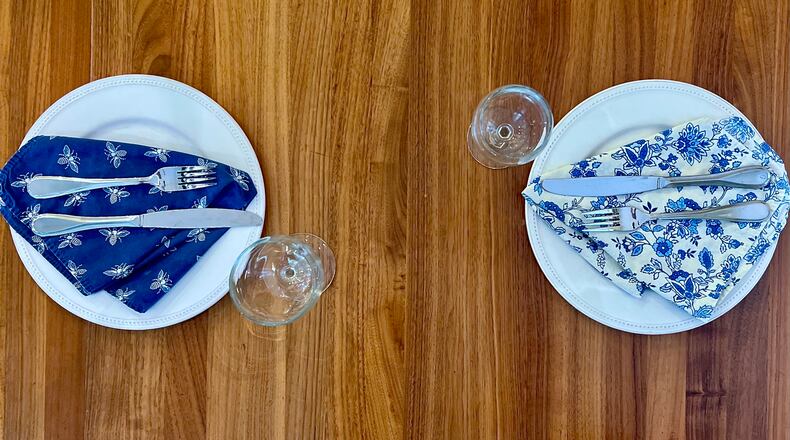Last month, our youngest chick left the nest in a move that felt equally long-anticipated and shockingly abrupt. The loss hits hardest when I set our too-big table for just my husband and me. This is probably why I still cook like the high school offensive line might drop by for a casserole. I shove leftovers into my friends’ refrigerators with both hands, stuck in a crazy, sad game called They Grow So Fast, Have Some Lasagna. After literal decades of cooking for a crowd, how do I ... not?
“The Complete Cooking for Two Cookbook, 10th Anniversary Edition” by America’s Test Kitchen (America’s Test Kitchen, $40) explains that feeding smaller households isn’t as simple as slashing recipes for four. As the introduction ponders, how do you halve a single egg? (Page 30 advises whisking the yolk and egg together, then using half of the liquid.) Another option is to select one of 700+ recipes in this updated edition, none of which require calculating fractions.
The section on avoiding food waste is reshaping my approach to home economics. Buying in bulk isn’t truly cost-effective if the fruits of your shopping trip languish in the refrigerator. When a recipe calls for a little chopped onion, I can skip the 5-pound bag and purchase just one, or even substitute an inexpensive shallot. If I grab 8 ounces of ground beef from the meat counter instead of a prepackaged pound, my friends will have less of my lasagna — and emotions — thrust upon them.
For ingredients that don’t come in smaller quantities, the section on using up leftovers provides options, including tips for freezing and storing, and complementary recipes referenced with page numbers. After chopping half an eggplant for Ciambotta, the Italian version of ratatouille, I saved the remaining aubergine for Garlicky Pork with Eggplant, whose Asian-inspired flavors didn’t taste like repetition.
As with so many other parts of this transition into empty-nester-hood, I have mixed feelings about the book’s suggestion to purchase smaller kitchen equipment. I don’t want a 4-quart slow cooker; a few beef short ribs cook just fine in the Cadillac-sized standby that made our dinner while I drove to every sports game and practice for 15 years. But households of all sizes do need the 5 ½-by-3-inch loaf pan to make the recipe for Banana Bread that uses just one very ripe banana. It bakes a little loaf as warm and sweet as the traditional recipe, and my not-full house smells like home.
RECIPES
Cooking for smaller households isn’t as simple as reducing the size of a recipe. You may need different shopping strategies, ingredients or equipment. Recipes written for two, like the following savory dishes and smaller banana bread loaf, help you reduce food waste and save money.
Credit: Daniel J. van Ackere
Credit: Daniel J. van Ackere
Ciambotta
A 5-pound bag of potatoes costs less per pound, but if you won’t use them all before they turn soft, you’re throwing away money with the spuds. Consider buying an individual yellow potato for this recipe instead.
Wrap leftover pecorino Romano in plastic wrap, seal it in a zip-close bag, and freeze it for up to two months.
3 tablespoons extra-virgin olive oil, divided, plus more for serving
½ eggplant (8 ounces), unpeeled, cut into 1‑inch pieces
1 Yukon Gold potato (8 ounces), peeled and cut into ½‑inch pieces
1 (14.5‑ounce) can whole peeled tomatoes, drained with juice reserved
3 garlic cloves, minced
1 teaspoon tomato paste
¼ teaspoon minced fresh oregano or pinch dried
¼ teaspoon table salt, plus more to taste
¼ teaspoon pepper, plus more to taste
3 cups vegetable broth
1 small zucchini, halved lengthwise, seeded, cut into 1‑inch pieces
2 tablespoons chopped fresh basil
¼ cup grated pecorino Romano cheese
Heat 2 tablespoons oil in medium saucepan over medium-high heat until shimmering. Brown eggplant lightly on all sides, 5 to 7 minutes; transfer to bowl. Microwave potato and 1 teaspoon oil in covered bowl until softened, about 5 minutes.
Heat remaining 2 teaspoons oil in now-empty saucepan over medium heat until shimmering. Add tomatoes, garlic, tomato paste, oregano, salt and pepper and cook until mixture is dry and beginning to brown, 11 to 13 minutes.
Stir in broth and reserved tomato juice, scraping up any browned bits. Stir in browned eggplant, softened potato and zucchini and bring to simmer. Reduce heat to medium-low, partially cover and simmer until vegetables are tender and stew has thickened, 25 to 35 minutes. Gently stir in basil and season with salt and pepper to taste. Sprinkle individual portions with pecorino and drizzle with extra oil before serving.
Serves 2.
Per serving: 506 calories (percent of calories from fat, 50), 17 grams protein, 49 grams carbohydrates, 17 grams total sugars, 9 grams fiber, 30 grams total fat (8 grams saturated), 31 milligrams cholesterol, 1,825 milligrams sodium.
Recipes adapted from “The Complete Cooking for Two Cookbook, 10th Anniversary Edition” by America’s Test Kitchen (Penguin, 2024).
Credit: Daniel J. van Ackere
Credit: Daniel J. van Ackere
Garlicky Pork with Eggplant
If your bag of brown sugar hardens before you can use it all, make your own by mixing a ratio of 1 tablespoon molasses to 1 cup granulated sugar and storing it in an airtight container. Double the quantity of molasses to make dark brown sugar.
If you don’t have a wok, substitute a 12-inch nonstick skillet with a tight-fitting lid.
¼ cup chicken broth
3 tablespoons vegetable oil, divided
1 tablespoon packed light brown sugar
2 teaspoons fish sauce
2 teaspoons soy sauce
1 teaspoon lime juice
1 (12‑ounce) pork tenderloin, trimmed and sliced into ¼-inch thick medallions
½ teaspoon cornstarch
6 garlic cloves, minced
½ teaspoon pepper
½ eggplant (8 ounces), unpeeled, cut into ¾‑inch pieces
1 small onion, halved and sliced ¼-inch thick
2 tablespoons chopped fresh cilantro
Rice, for serving
Make the sauce: Whisk broth, 1 tablespoon oil, sugar, fish sauce, soy sauce and lime juice in a small bowl. Measure 1 tablespoon sauce into medium bowl, reserving the remainder in the small bowl.
Add pork, cornstarch and 1 tablespoon oil to the medium bowl and stir. Cover and marinate pork in refrigerator for at least 10 minutes or up to 30 minutes. Meanwhile, in a third bowl, combine garlic, pepper and 1 teaspoon oil.
Heat remaining 2 teaspoons oil in 14-inch flat-bottomed wok over high heat until just smoking. Add eggplant and onion, cover and cook until vegetables are softened and lightly browned, about 3 minutes. Uncover and continue to cook until vegetables are tender, about 5 minutes. Transfer to a clean medium-sized bowl.
Return now-empty wok to high heat. Add pork with marinade and cook until no longer pink and liquid has evaporated, 4 to 6 minutes. Push pork to sides of wok. Add garlic mixture to center and cook, mashing mixture into wok, until fragrant, about 1 minute. Stir garlic mixture into pork.
Stir in cooked vegetables. Whisk reserved sauce to recombine, then add to wok. Cook, stirring constantly, until sauce is thickened, about 1 minute. Transfer to serving platter, sprinkle with cilantro, and serve hot over rice.
Serves 2.
Per serving, without rice: 467 calories (percent of calories from fat, 51), 38 grams protein, 19 grams carbohydrates, 10 grams total sugars, 4 grams fiber, 27 grams total fat (5 grams saturated), 111 milligrams cholesterol, 921 milligrams sodium.
Credit: Daniel J. van Ackere
Credit: Daniel J. van Ackere
Slow-Cooker Braised Short Ribs with Hoisin Sauce
If you can’t find boneless short ribs, purchase 1 pound of bone-in ribs and trim the meat yourself with a sharp paring knife.
Mix leftover hoisin sauce with a mild vinegar, ginger and scallions to make a vinaigrette.
½ cup chicken broth
⅓ cup hoisin sauce
3 scallions, white parts minced, green parts sliced thin
1 tablespoon chile-garlic sauce
2 teaspoons instant tapioca
10 ounces boneless beef short ribs, trimmed
¼ teaspoon table salt
⅛ teaspoon pepper
Egg noodles or rice, for serving
Lightly spray the inside of a slow cooker with vegetable oil spray. Add broth, hoisin, scallion whites, chile-garlic sauce and tapioca. Sprinkle beef with salt and pepper and nestle into slow cooker. Cover and cook until beef is tender, 8 to 9 hours on low or 5 to 6 hours on high.
Transfer short ribs to serving platter, tent loosely with aluminum foil, and let rest for 5 minutes. Using large spoon, skim and discard excess fat from surface of sauce. Pour sauce over short ribs and sprinkle with scallion greens. Serve hot with egg noodles or rice.
Serves 2.
Per serving (without noodles or rice): 600 calories (percent of calories from fat, 45), 58 grams protein, 25 grams carbohydrates, 14 grams total sugars, 2 grams fiber, 30 grams total fat (2 grams saturated), 218 milligrams cholesterol, 1,468 milligrams sodium.
Credit: Daniel J. van Ackere
Credit: Daniel J. van Ackere
Banana Bread
This mini loaf gets its tender crumb from a very ripe banana, melted butter and plain yogurt. The smaller loaf pan works equally well with two-person recipes for quick and yeast breads.
½ cup all-purpose flour
¼ cup walnuts, toasted and coarsely chopped
¼ cup sugar
½ teaspoon baking soda
⅛ teaspoon table salt
1/4 cup mashed ripe banana, from about 1 small banana
1 large egg, at room temperature
1 tablespoon unsalted butter, melted and cooled
1 tablespoon plain yogurt
½ teaspoon vanilla extract
Heat oven to 350 degrees with a rack in the middle. Grease a 5½-by-3‑inch loaf pan.
In a medium bowl, whisk flour, walnuts, sugar, baking soda and salt. In separate bowl, whisk mashed banana, egg, melted butter, yogurt and vanilla until smooth. Gently fold banana mixture into flour mixture with rubber spatula until just combined. Batter will be lumpy with a few spots of dry flour; do not overmix.
Scrape batter into prepared pan and smooth the top. Bake until loaf is golden brown and toothpick inserted in center comes out clean, 30 to 40 minutes, rotating pan halfway through baking.
Let loaf cool in pan on wire rack for 5 minutes. Remove loaf from pan and let cool for at least 1 hour before serving.
Serves 2.
Per serving: 424 calories (percent of calories from fat, 38), 9 grams protein, 58 grams carbohydrates, 30 grams total sugars, 3 grams fiber, 19 grams total fat (6 grams saturated), 47 milligrams cholesterol, 499 milligrams sodium.
Sign up for the AJC Food and Dining Newsletter
Read more stories like this by liking Atlanta Restaurant Scene on Facebook, following @ATLDiningNews on X and @ajcdining on Instagram.
About the Author
Keep Reading
The Latest
Featured







